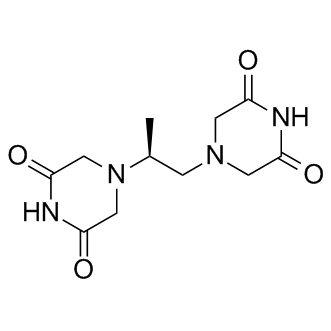
Dexrazoxane
CAS No. 24584-09-6
Dexrazoxane( ICRF-187 | NSC-169780 )
Catalog No. M13714 CAS No. 24584-09-6
A derivative of EDTA that chelates iron and reduces the number of metal ions complexed with anthracycline and, consequently, decrease the formation of superoxide radicals.
Purity : >98% (HPLC)
 COA
COA
 Datasheet
Datasheet
 HNMR
HNMR
 HPLC
HPLC
 MSDS
MSDS
 Handing Instructions
Handing Instructions
| Size | Price / USD | Stock | Quantity |
| 25MG | 35 | In Stock |


|
| 50MG | 51 | In Stock |


|
| 100MG | 73 | In Stock |


|
| 500MG | 180 | In Stock |


|
| 1G | Get Quote | In Stock |


|
Biological Information
-
Product NameDexrazoxane
-
NoteResearch use only, not for human use.
-
Brief DescriptionA derivative of EDTA that chelates iron and reduces the number of metal ions complexed with anthracycline and, consequently, decrease the formation of superoxide radicals.
-
DescriptionA derivative of EDTA that chelates iron and reduces the number of metal ions complexed with anthracycline and, consequently, decrease the formation of superoxide radicals; protects the heart against the cardiotoxic side effects of chemotherapeutic drugs.Chemotherapeutic Agents Approved
-
In Vitro——
-
In Vivo——
-
SynonymsICRF-187 | NSC-169780
-
PathwayOthers
-
TargetOther Targets
-
RecptorOther Targets
-
Research AreaCancer
-
IndicationChemotherapeutic
Chemical Information
-
CAS Number24584-09-6
-
Formula Weight268.2691
-
Molecular FormulaC11H16N4O4
-
Purity>98% (HPLC)
-
Solubility10 mM in DMSO
-
SMILESC[C@H](N(C1)CC(NC1=O)=O)CN(C2)CC(NC2=O)=O
-
Chemical Name2,6-Piperazinedione, 4,4'-[(1S)-1-methyl-1,2-ethanediyl]bis-
Shipping & Storage Information
-
Storage(-20℃)
-
ShippingWith Ice Pack
-
Stability≥ 2 years
Reference



-
N-[(4-methylphenyl)c...
N-[(4-methylphenyl)carbamothioyl]-2-nitrobenzamide can be used in the synthesis of N-aryl-N'-(o-nitrobenzoyl)thiourea derivatives and related research.
-
WSB1 Degrader 1
WSB1 Degrader 1 is a poten and orally active?WD repeat and SOCS box-containing 1 degrader. WSB1 Degrader 1 has anticancer metastatic effects.
-
Humanin (human)
Humanin, an anti-apoptotic peptide of 24 amino acids, is a Bax inhibitor. Humanin prevents the translocation of Bax from cytosol to mitochondria, blocks Bax from the inactive to active conformation. Humanin is a mitochondria-associated peptide with a neuroprotective effect against AD-related neurotoxicity. Humanin also improves overall insulin sensitivity in animal. Humanin are related to aging. Humanin analogue, in which the serine at position 14 is replaced by glycine, names HNG.



 Cart
Cart
 sales@molnova.com
sales@molnova.com


